|
45. Lampides boeticus (Linnaeus, 1767) / Long-tailed blue / Lycaenidae – Polyommatinae
NL: tijgerblauwtje / D: Großer Wander-Bläuling, Geshwanzter Blasenstrauchbläuling / F: argus porte-queue, azuré porte-queue
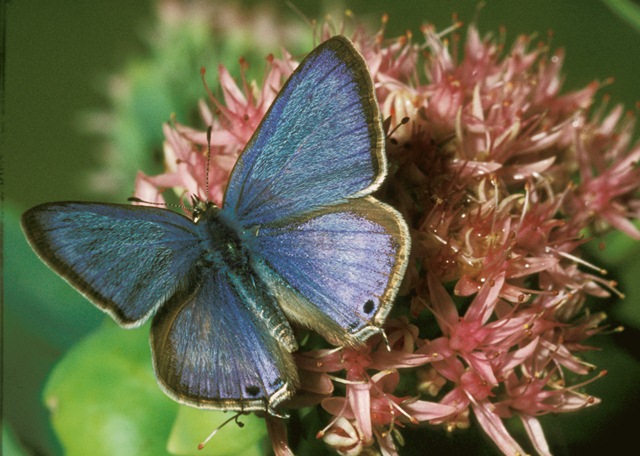 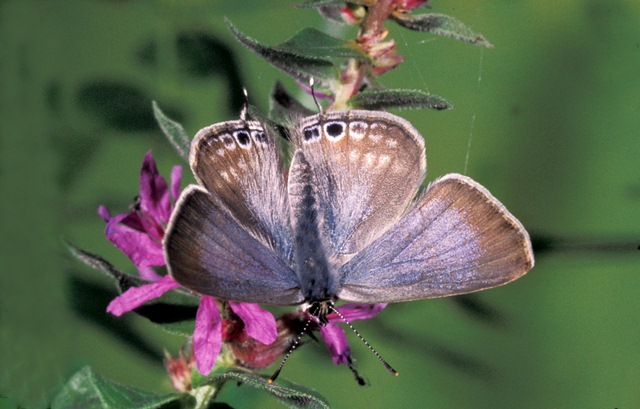 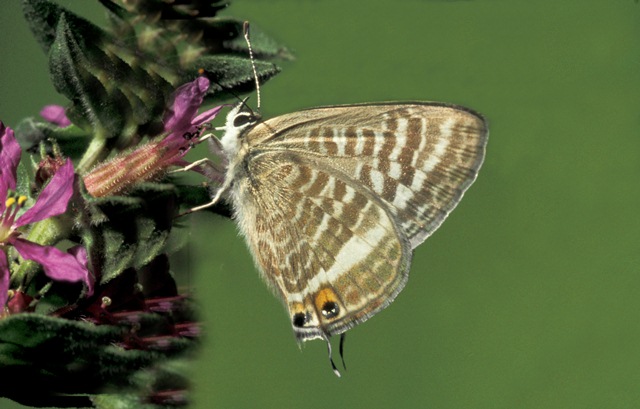
Photographs: Frits Bink ©.
Small, variable in size, wing length 15 (13-17) mm. This species has an almost worldwide distribution and is observed sometimes in the Benelux. It can be transported there either by importing peas or beans form Africa or alternatively by migration, because it is a strong flyer.
Butterflies are on the wing in the period from mid-July until early October, required heat sum is 1500°d (sub-mediterranean climate) and the maximum tolerated 5000°d (tropical climate) and, at sites where the average temperature of the coldest month is above 5°C, there is a chance this species may survive the winter in the egg-stage.
This may be possible where the climate window is more than 33 weeks.
The species occurs in the temperate climate zone as a vagrant and in the tropical area it is a nomad with a large spatial requirement.
(Tip for insect breeder: the larvae can easily be fed on a broken French bean).
Ecological characteristics
Behaviour over time
Overwintering: the egg stage is regarded as a possible overwintering stage, attached to a twig.
Reproduction: oviposition starts after 5-8 days when the body contains 28 (24-32) eggs, estimated potential production 6 times as much.
Larval feeding periods: three weeks in summer period.
Generations: 4-5 in Mediterranean climate.
Spreading of risk: the nomadic lifestyle and long life span of the adult ensure that the species can survive inclement environments.
Life cycle: egg 6 (4-7) days, up to 12 weeks in the case of overwintering; larva 20 (14-25) days; pupa 14 (10-18) days.
Life span of adult: long, 4 weeks.
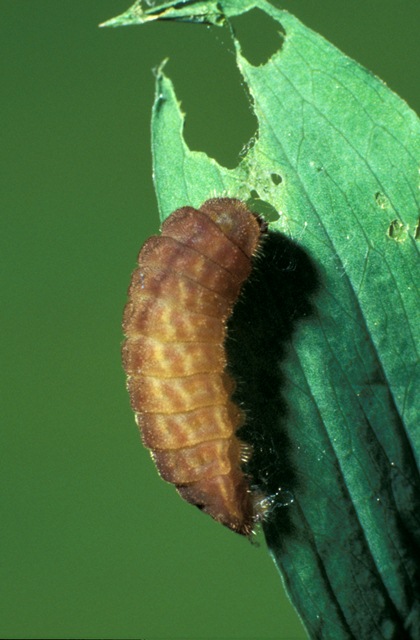
Photographs: Frits Bink ©.
Behaviour in space
From stay-at-home to migrant: a stray in the Benelux.
Finding a mate: male sometimes perches, other times patrols.
Orientation in the landscape: gradient from open fields to shrub land.
Oviposition: on the calyx of buds, young flowers or shoots.
Defence
Threats from other organisms: larva lives hidden in the pod of the host plant.
Myrmecophily: weak, larva lives outside the reach of ants, except during pupation in the litter layer.
Threats from the environment: the adult butterfly endures heat and drought quite well.
Feeding habits
Adult: nectar of all kind of flowers, purple loosestrife is a favoured one.
Larva: eats mainly seedpods but occasionally, when nearly full grown, leaves or young shoots.
Larval foodplants
Plant species: Fabaceae, herbs e.g. Lathyrus latifolius, Phaseolus vulgaris, Pisum sativum and shrubs e.g. Colutea arborescens, Genista hispanica, Spartium junceum.
Journal
Rearing experiments:
First based on specimens from Aurel, France:
29 August 1984: eggs and larvae collected from Lathyrus latifolius.
6 September: those larvae collected as eggs in L2, the others in third, fourth or fifth instar. One pupa killed, cannibalism!
9 September: those larvae collected as forth or last instar were now pupated.
12 September: larvae collected as eggs were fully grown and one hidden under wilted leaf.
18 September: another larva under a leaf, one pupated.
22 September: two pupae near to hatching, last larva pupated. Pupae were girdled and hidden in the litter layer.
10 October: all pupae hatched, thus no hibernation in the pupal stage.
Second based on specimen from Quarteira, Portugal:
18 November 1985: eggs collected from Spanish gorse (Genista hispanica).
31 November: one egg out of five hatched.
5 December: larva moulted and bored into a young fruit of Lotus cretica.
10 December: larva end of L4.
16 December: larva pupated.
24 December: adult emerged.
2 January 1986: no other eggs hatched.
Table 45-1. Results of dissections

Table 45-2. Collection and observation localities
E, La Grannadella, Alicante 38° 43’ 43” – 0° 10’ 38”E; 17 December 1998 (oviposition observed).
F, Aurel, 400 m, 44° 43’N – 5° 16’E; 29 August 1984, 2 September1984 (eggs, larvae).
F, Saint-Nazaire-le-Desert 44° 29’N – 5° 22’E; 1 September 1984 (eggs, larvae).
P, Quarteira 37° 03’ 45”N – 8° 04’ 20”W; 19 November 1985, 23 November 1985 (eggs and larvae).
Fig. 45-1. Lampides boeticus, designed phenogram from Benelux observations.
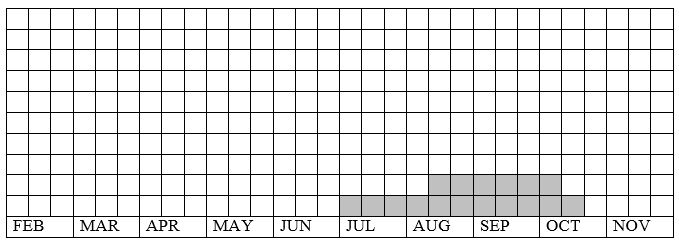
Fig. 45-2. Lampides boeticus, habitat characteristics.
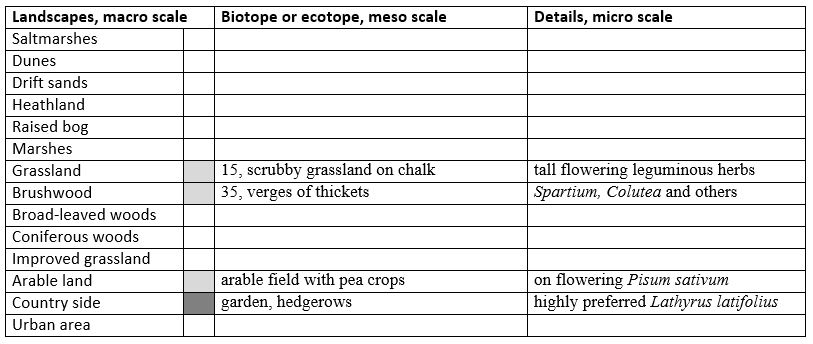
Fig. 45-3. Lampides boeticus, climate matrix, heat-sums 1500-5000°d, January +5ºC.
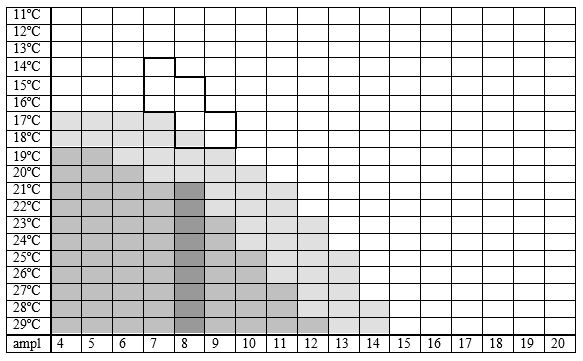
|









